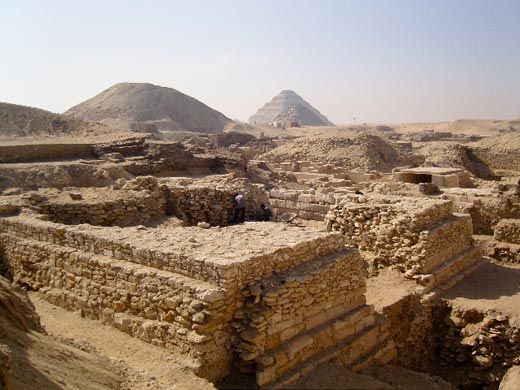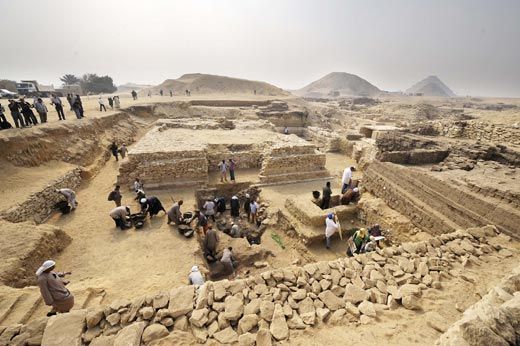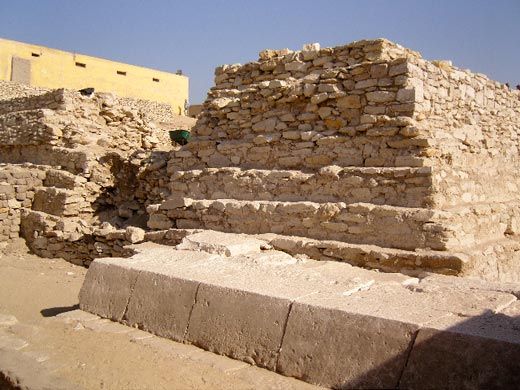The Tomb of Queen Sesheshet
A recently discovered pyramid and tomb in Egypt may shed light on a dark episode in a pharaonic tradition of court intrigue
/https://tf-cmsv2-smithsonianmag-media.s3.amazonaws.com/filer/Tomb-of-Queen-Sesheshet-necropolis-of-King-Teti-at-Saqqara-631.jpg)
"Let's start from the beginning," Abdel Hakim Karar suggests as he scampers up the north side of an archaeological dig of sun-bleached pink stone and gravel.
When you make your living unearthing the royal riches of ancient Egypt, the beginning is a very distant place indeed – more than four millennia away, during the time of the 6th dynasty. We are standing on the rim of the necropolis of King Teti at Saqqara, where Karar and his team of archaeologists are excavating the tomb of Queen Sesheshet, Teti's mother. The tomb, and the once five-story-high pyramid that accommodates it, was until recently a dump for the sand and detritus of surrounding digs. But the intuitive power of Karar and his inimitable boss, Zahi Hawass, secretary general of Egypt's Supreme Council of Antiquities, rescued it from oblivion last November. It was a once-in-a-lifetime strike – how often does one "discover" a pyramid? – and it may shed light on a particularly notorious episode in a pharaonic tradition of court intrigue and murder most foul.
"We suspected this was the mother's pyramid," says Karar, as he gestures to a horizon line interrupted only by the iconic step pyramid of Saqqara, the Eiffel Tower of its time, built by the legendary 3rd dynasty ruler Imhotep. "Then we came across stones carved with the characters for 'Seshi' and we knew what it was."
The surrounding complex was discovered and unearthed by a fraternity of French and British archaeologists in the mid-19th century. Its centerpiece is the pyramid of Teti, the first ruler of the 6th dynasty, and the subsidiary pyramids of his two principal wives, queens Iput I and Khuit. Like many such digs in Egypt -- a country that, because of its strategically vital location, has played host to several great civilizations -- Saqqara offers a bounty of archaeological wealth beyond what was once the property of pharaohs. Enveloping the site is a containing wall of dung-colored mud bricks built in 330 B.C. by Ptolemy I, the Macedonian general who campaigned with Alexander the Great and who may have been mentored by Aristotle. The U-shaped wall contained a drawing of the funeral procession that followed the death of a sacred bull as ordained under Serapis, the Greek deity promoted by Ptolemy as a way to fuse Hellenist and Greek religions.
Hawass, who began working at the Saqqara necropolis in 1988, says Sesheshet's pyramid "might be the most complete subsidiary pyramid ever found" in the area. It is certainly one of the largest. The remains of its 72-square-foot base suggests a pitch of 51 degrees, a common feature of 5th and 6th century pyramidal design, and a height of 46 feet. Large, smoothly carved blocks of limestone around the southern end of its foundation is all that's left of the casing that gave Egyptian pyramids of the time their clean, elegant lines. The entire structure would have been built with bronze tools. Karar and his team waited several weeks before opening the tomb's burial chamber so as not to disrupt the remains while the surface excavation was going on. In January, when they finally entered the chamber, they found a mummy inside wrapped in linen and conclusive evidence to suggest it is Sesheshet, Hawas told the Cairo-based Al Ahram Weekly. Beginning in the 4th dynasty, the kings of Egypt were careful to commemorate their wives and mothers with regal monuments. (In a monograph published in a 2000 edition of Archiv orientalni, a quarterly Czech archaeological journal, Hawass hinted at the possibility of a third subsidiary pyramid in honor of Teti's mother.) Yet the size and grandeur of Sesheshet's pyramid is as much a political statement as it is an expression of filial piety. Sesheshet came from a powerful family at a time of civil war within the royal clan and she protected Teti for much of his 20-year rule. Sadly for Teti, her talismanic powers did not extend from the grave; after her death, according to the Ptolemaic historian Manetho, Teti was murdered by his own bodyguards working in league with the treacherous Userkare. In testament to the hardboiled political culture of the time, Userkare himself was ousted by Pepy I, son of Queen Iput I, only a few years after he had seized the throne. While Manetho is vague as to Userkare's fate, there are few surviving monuments to his rule, the modern-day equivalent of being airbrushed out of the history books and a fate worse than death in edifice-obsessed ancient Egypt. While Sesheshet's tomb is believed to have been plundered by thieves, like many Egyptian pyramids, the artifacts discovered in Iput I's burial chambers offer a glimpse of what might have been kept there: vessels and dishes made of alabaster and red clay, tools lacquered in gold, a sarcophagus carved from limestone and layered with gypsum, and canopic jars filled with the royal viscera in storage for the afterlife. The walls and pillars of the tomb may depict scenes of court life and religious rites and there will likely be granite stele with inscriptions identifying the royal matron as a "mother of the king of Upper and Lower Egypt." Karar, who studied at Cairo University and has spent half of his 50 years digging up ancient relics, says he hopes the tomb will also yield new details about how the ancient Egyptians related to other such geopolitical powers as Rome, Nubia, Syria, Greece and Persia. The record of Sesheshet's era is particularly incomplete, he says, which is another reason why the discovery of her pyramid is so significant. "It's never boring," says Karar of his profession. "Egyptians now appreciate what we do because of the attention it is getting in the media. They no longer take their heritage for granted." Sesheshet, whose name evokes a goddess of history and writing, would have approved.




